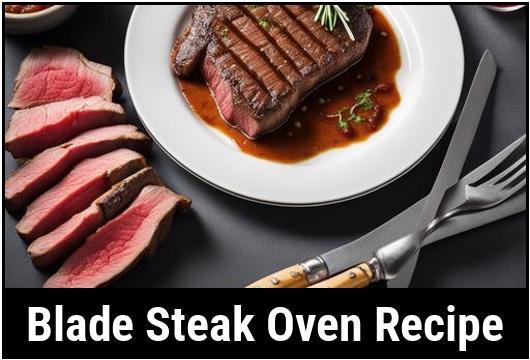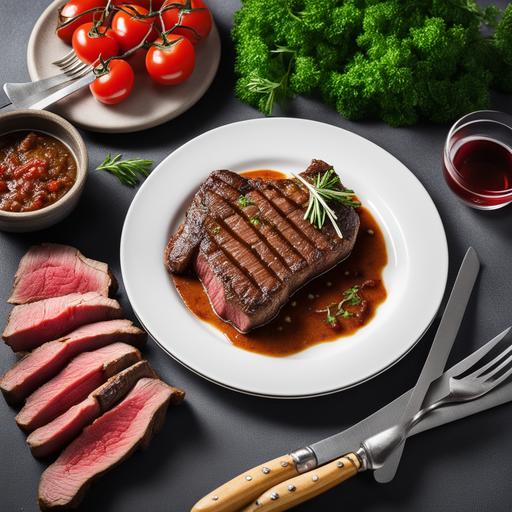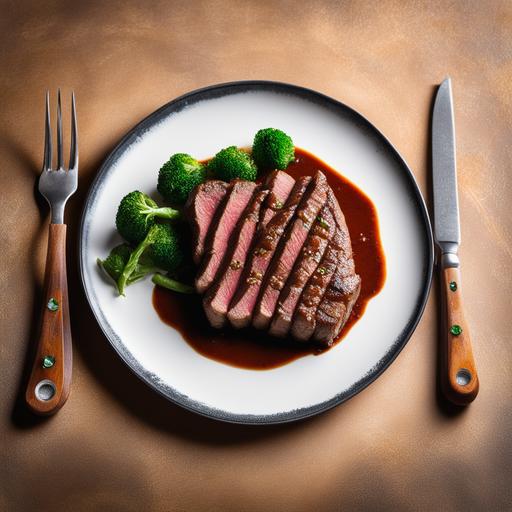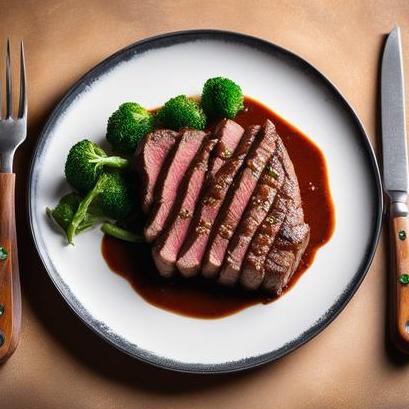
Blade Steak Oven Recipe: Savory Perfection
Delight your taste buds with this tender and flavorful blade steak prepared to perfection!
Are you looking for a mouthwatering and hassle-free way to enjoy a delectable blade steak? Look no further! In this comprehensive guide, we will explore the culinary delights of blade steak, discuss its selection, cleaning, and preparation, and provide you with an easy-to-follow recipe that will leave your taste buds dancing with joy. Whether you’re new to cooking or a seasoned chef, this article has got you covered, so let’s dive right in!
Understanding Blade Steak
Blade steak, also known as chuck steak or shoulder steak, is a versatile cut of meat that is derived from the chuck portion of a beef carcass. This flavorful and economical cut contains marbling, connective tissue, and a central blade bone, which imparts rich flavors and contributes to its tenderness when cooked properly. Blade steaks are best suited for slow cooking methods, making them an ideal choice for oven recipes.
Selecting the Perfect Blade Steak
When it comes to selecting blade steak, there are a few key factors to consider. Look for cuts that are well-marbled with thin, even streaks of fat. The fat not only adds flavor but also contributes to the tenderness of the meat. Additionally, opt for steaks that have a deep red color, as this indicates freshness.
Cleaning and Preparing Blade Steak

Before diving into the culinary wonders of blade steak, proper cleaning and preparation are essential. Follow these steps to ensure a delectable outcome:
-
Start by removing the blade steak from the packaging and pat it dry with a paper towel.
-
If there are any visible chunks of fat, trim them off using a sharp knife. However, be careful not to remove all the fat, as it helps maintain the juiciness and flavor.
-
Season the steak generously with salt and pepper, or your preferred blend of spices, to enhance its flavor profile.
-
Allow the steak to rest at room temperature for around 15-20 minutes. This helps the meat cook more evenly.
Tips for Success

To ensure your blade steak turns out tender and flavorful, here are some additional tips to keep in mind:
-
Marinating: Consider marinating your blade steak in a flavorful marinade for a few hours or overnight. This step will infuse the meat with extra flavors and help to tenderize it further. Some popular marinade options include Worcestershire sauce, soy sauce, red wine, garlic, and herbs.
-
Slow Cooking: Blade steak requires slow and gentle cooking to break down the connective tissues and become tender. The oven is an excellent tool for achieving this slow cooking process, as it allows for even heat distribution.
-
Braising Liquid: Adding a flavorful braising liquid, such as beef stock, red wine, or a combination of both, can elevate the taste of your blade steak. The liquid will keep the meat moist while imparting delicious flavors throughout the cooking process.
-
Resting Period: After cooking, allow the blade steak to rest for a few minutes so that the juices can redistribute evenly. This step ensures a moist and succulent final result.
Achieving the Perfect Doneness

Determining the desired level of doneness is crucial when cooking blade steak. To achieve your preferred level of doneness, use a meat thermometer or the touch test:
-
Rare (125-130°F): The meat will feel very soft and spongy when touched lightly with a finger.
-
Medium-Rare (135-140°F): The meat will feel firm yet slightly springy when touched.
-
Medium (145-150°F): The meat will have a firmer texture and yield a little less when touched.
-
Medium-Well (155-160°F): The meat will be firm with just a slight give when touched.
-
Well-Done (165°F and above): The meat will be firm to the touch with no give.
Blade Steak Oven Recipe

Now that we’ve covered the important aspects, it’s time to embark on an epic culinary journey with our delicious blade steak oven recipe. This recipe incorporates flavorsome herbs, aromatic garlic, and tenderizing techniques to ensure a memorable dining experience. Gather your ingredients and follow these simple steps:
Ingredients:
-
2 pounds blade steak
-
2 tablespoons vegetable oil
-
1 tablespoon minced garlic
-
1 tablespoon fresh rosemary, chopped
-
1 tablespoon fresh thyme leaves
-
Salt and pepper to taste
-
1 cup beef broth
-
Optional: Red wine for deglazing
Instructions:
-
Preheat your oven to 325°F (163°C) and position the rack to the center.
-
Heat a large oven-safe skillet or cast-iron pan over medium-high heat.
-
Add vegetable oil to the skillet and heat until shimmering but not smoking.
-
Place the blade steaks in the skillet, ensuring they are not overcrowded. Sear each side for about 3-4 minutes until they develop a golden brown crust.
-
Once seared, remove the steaks from the skillet and set them aside on a plate.
-
Lower the heat to medium and add the minced garlic, rosemary, and thyme to the skillet. Cook for approximately 1 minute until fragrant.
-
If desired, deglaze the skillet by adding a splash of red wine. Use a wooden spoon to scrape any browned bits from the bottom of the skillet, as they are packed with flavor.
-
Return the blade steaks to the skillet and carefully pour in the beef broth. The liquid should come about halfway up the sides of the steaks.
-
Cover the skillet with a lid or aluminum foil, and transfer it to the preheated oven.
-
Allow the steaks to bake for approximately 2-3 hours, or until the meat becomes fork-tender and easily pulls apart.
-
Once the steaks have reached your desired level of doneness, remove them from the oven and let them rest for a few minutes.
-
Serve your succulent and flavorful blade steaks with a drizzle of the pan juices and a side of your choice. Enjoy!
Variations and Enhancements
While our recipe provides a delicious foundation, you can personalize your blade steak even further with these creative variations:
-
Herb-Infused Butter: Prepare a compound butter by mixing softened butter with your favorite herbs, such as rosemary, thyme, or parsley. Top your cooked steak with a pat of this savory butter, allowing it to melt and enhance the flavors.
-
Mushroom Sauce: Sautee some sliced mushrooms in butter until golden brown. Add a splash of red wine and reduce. Finish by adding a splash of cream for a creamy mushroom sauce, perfect for drizzling over your blade steak.
-
Citrus Marinade: Infuse your blade steak with a burst of tangy flavors by marinating it in a mixture of orange juice, lime juice, soy sauce, garlic, and honey. Allow the meat to marinate for a few hours before cooking.
-
Grilled Vegetables: Alongside your blade steak, grill some fresh vegetables like zucchini, bell peppers, or asparagus for a colorful and nutritious side dish.
-
Garlic Mashed Potatoes: Pair your blade steak with creamy garlic mashed potatoes for a classic steakhouse-inspired meal.
Avoiding Common Mistakes
To ensure your blade steak turns out flawlessly, let’s discuss a few common mistakes and how to avoid them:
-
Overcooking: Blade steak is best enjoyed when cooked to medium-rare or medium. Overcooking can result in a tough and dry steak. Use a meat thermometer to monitor the internal temperature and avoid overcooking.
-
Under-seasoning: Blade steak benefits from generous seasoning. When seasoning the meat, be sure to add enough salt and pepper to enhance the flavors of this delicious cut.
-
Insufficient Resting Time: Allowing the blade steak to rest after cooking is vital. This resting period allows the juices to redistribute, ensuring a juicy and flavorful eating experience. Be patient and resist the temptation to cut into the steak immediately.
In Conclusion
Congratulations! You are now equipped with a comprehensive understanding of blade steak, from selecting the perfect cut to preparing it to perfection. Armed with our detailed oven recipe and variations, you can confidently take on this culinary adventure. Remember to experiment with flavors, perfect your desired doneness, and don’t shy away from exploring different accompaniments. With each mouthwatering bite, you’ll appreciate the artistry behind cooking a perfectly tender and flavorful blade steak. Enjoy!
Sources
FAQS On Blade Steak Oven Recipe
What Is The Best Temperature To Cook Blade Steak In The Oven?
For optimum tenderness, cook blade steak at a low temperature of 325°F (165°C).
How Long Should I Cook A Blade Steak In The Oven For?
The cooking time for blade steak in the oven varies depending on the thickness of the steak, but on average it takes about 20-25 minutes per pound.
Do I Need To Marinate Blade Steak Before Cooking?
It is not necessary to marinate the blade steak before cooking, but you can if you prefer. The added flavor and tenderness can improve the overall result.
Can I Use A Baking Dish Instead Of A Roasting Pan?
Yes, a baking dish is a suitable alternative to a roasting pan for cooking blade steak in the oven. Just make sure it is large enough to hold the steak and juices.
Should I Cover The Blade Steak While Cooking In The Oven?
It is recommended to cover the blade steak with foil while cooking in the oven. This helps to keep the meat moist and tender, as well as preventing it from drying out. Remove the foil during the last few minutes of cooking to allow the steak to brown and develop a crust.



